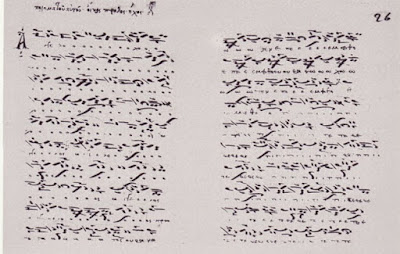 |
| Madrid, Escorial, Codex P.I. 19, p. 26. "Akathist Hymn", end of 14th or beginning of 15th cent. |
The Akathist Hymn is a shining monument of early Byzantine hymnography. It is a kontakion with an alphabetical acrostic, which is entirely used still today, preserving a centuries-old worship practice.
Morphologically it is worth noting that the kontakion of the Akathist differs from the traditional form of the kontakion. The oikoi are not all alike, as there are an uneven number (Α, Γ, Ε), which are more far-reaching, and contain the known greetings which end with the short hymn "Rejoice, Bride unwedded". Conversely the oikoi with uneven numbers (Β, Δ, Ζ) are shorter and end with the short hymn "Hallelujah". This is an indication that shows the kontakion of the Akathist does not belong to the peak period of the kontakia, but possibly closer to the emergence of the poetic genre, the canon (800's), and the various forms that distinguishes it.
 |
| Leimonos 245, Papadike Anthology |
The text of the Akathist Hymn is found in many manuscripts. The oldest are:
- Vatopaidi codex 1041 (10th-11th cent.)
- Great Lavra codex C 27 (10th-11th cent.) and C 28 (11th cent.)
- Patmian codex 212 and 213 (11th cent.)
The hymn was published for the first time by Aldus Manutius in Venice in 1502. In 1867 Cardinal Pitra ran a first philological edition and then followed with a multitude of critical and literary publications. In liturgical books it holds an important position among the first printed editions (March Menaion, Triodion and the Horologion). Its effect on Byzantine hymnography was decisive. Kontakia of other feasts, great saints, and that of the Honorable Cross are adopted from the prosomoia of the Akathist Hymn. In the doxastikon idiomelon it is still customary to use the phrase "Rejoice".
It should be noted that the musical codexes that contain the hymn amount to 700 and extend from the 13th century to the 19th century with the interpreters of the New Method. The Kontakarion or Oikematarion is the codex that included the setting to music of the Akathist and was a key part of the Papadikos compositions. These compositions are simple, small and quick, but cosmetic compositions, with the extensive kalophonic and melismatic processing, as we can infer from the explanations.
 |
| Sinai 1575, John Plousiadinos |
We include the following codexes as examples:
- Παλίμψηστος Ε.β. VII της Κρυπτοφέρης (14th cent.)
- Αshburhamensis 64, (14th cent.)
- ΕΒΕ 2405 (14th cent.)
- Iveron 972/1057 (15th cent.)
- Sinai 1262, (15th cent.) Gregory Bounis the Alyatis
- Sinai 1575, (15th cent.), John Plousiadinos
- Koutloumousiou 448 (16th cent.), Benedict Episkopopoulos
- Xeropotamou 330, Demetrios Lotos (18th cent.)
- ΕΒΕ-ΜΠΤ 713 and 714 (19th cent.) interpreted by Hourmouziou Hartophylakos
- ΕΒΕ-ΜΠΤ 754, Complete Peter the Bereketis (19th cent.) interpreted by Gregory the Protopsalti
The composers who composed the hymns are: Michael Aneotis or Anenoitis 13th c., John the Glykis, Nikephoros Ethikos, Xenophon Koronis, St. John Koukouzeles, John Kladas, John Tzaknopoulos, Manuel Chrysaphes, John Plousiadinos, Chrysanthos the New, Benedict Episkopopoulos, Balasios the priest, Anthony the priest, Peter the Peloponnesian, Peter the Bereketis, Anastasios Rapsaniotis, Parthenios the Meteorite, Demetrios Lotos, and Joasaph the Dionysiatis.
 |
| Koutloumousiou 457, 14th cent. |
Based on the rich manuscript tradition the Akathist Hymn, unlike the other kontakia and the usual practice of Byzantine composers to only compose the first oikos of the kontakion, it received particular compositional attention. Obviously this refers to an earlier liturgical and compositional importance, which is lost in the beginnings of kontakia notation and in the context of the detection of an archaic movement of the hymn.
Finally the hymnographical and musical philology makes me wonder and be amazed somewhat of the numerous feelings of the lovers of the Theotokos who produced so many rows of manuscripts. It seems that the Theotokos is the reference point and the expression of the piety and faith of Orthodox spirituality and life. From this perspective, we can say that the poet of the Akathist Hymn, who remains unknown, becomes everyone who has chanted and set to music, in a sophisticated or simple way, the hymn, or the one who silently chants with the Angel to our Mother the "Rejoice, Bride unwedded".
Source: Translated by John Sanidopoulos.